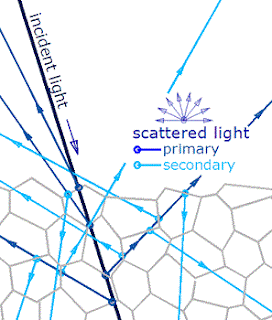 |
| diffuse reflection ice crystals in snow |
Dubroff opened with some flowery stuff about romanticizing snow's whiteness in song, but once she'd identified Irving Berlin, she fell off her turnip truck. We think her problem is that, while attempting to reword an article written by someone who knew what she was talking about (perhaps some story like this one), she started running into vocabulary problems. You see, Dee just didn't understand that there are real differences between the technical terms she attempted to use as synonyms. Take, for instance, this sentence:
"Visible light from the sun is composed of a series of wavelengths of light and our eyes detect these varying frequencies as different colors."Not quite accurate, Dee: 1) visible light from every star, not just "the sun," is 2) composed of a range of wavelengths (not a "series"), and our eyes sense color on the basis of those wavelengths, not their "frequencies." Otherwise, you're right... except when you get to trying to explain why snow is white, even though it's made of tiny, transparent crystals of ice. Let us explain it...
Dee managed to transcribe that more or less correctly, but then she wandered off into cloud-cuckoo land with claims such as,
- "As light hits the snow on the ground, light reflects everywhere around it and no single wave length of light gets absorbed or reflected with any consistency. Most all of the white light from the sun hitting the snow will reflect back to the ground, making the fallen snow appear white.": We aren't sure what that means, frankly.
- "...the answer to the question of why is snow white concerns the translucent nature of the tiny ice crystals that comprise it. Light does not easily pass through ice and instead bounces back and forth within the crystallized formation.": No, Dee, it's caused by refraction and reflection of light due to the difference in the speeds of light and air (not to mention Snell's Law). You know (or don't...), refraction and reflection?
| Dubroff's mishmash of science factoid and misunderstood scientific basics is pretty much what we've come to expect from our freelancers with liberal arts backgrounds when they try to talk all science-y. Their rewards? they get named Dumbass of the Day... |
copyright © 2018-2022 scmrak
SI - OPTICS
No comments:
Post a Comment